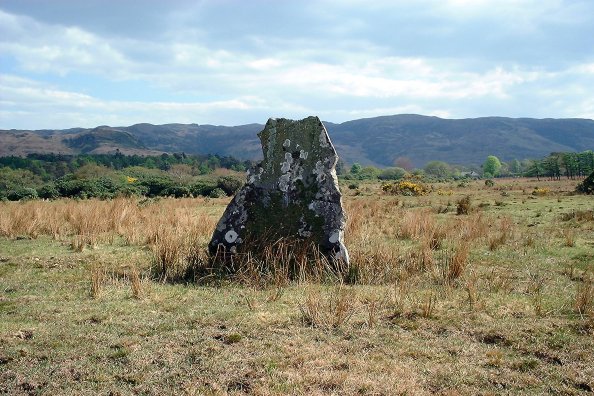
Looking south

Looking south

The west face of the stone
This stone stands around 50m to the SE of the chambered cairn, visible in the background in one of the photos. It is around 1.4m in height, and about 0.7m in width at the base.

General view, showing the modern additions....

Viewed from the NW end

A small kist in the centre

View across one of the chambers on the SW edge
A large chambered cairn, but very ruinous now. Enough remains that the general shape and size can be made out. It was excavated in 1954, when it was measured at 190 feet in length, with width varying from 38 feet at the SE to 20 feet at the NW – it is oriented along a SE-NW axis. Four lateral chambers were noted from the SW side. Even in its present condition it is quite impressive, although walkers in the Glen have started a small cairn near the SE end, visible in the photographs.
This little group of sites lies within a small area of Glen Almond, up a private track. Permission must be sought to use this road. The group comprises a single standing stone, a very ruinous chambered cairn, and two remaining stones of a four-poster. It was quite misty the day I visited, and very peaceful in the glen.
Glengorm was originally known as Sorne. In 1850, the new landlord, one James Forsyth, began to ‘improve’ his estate in the usual fashion in the Highlands – by clearance. The main house was replaced by a large and imposing baronial ‘castle’. Forsyth sought advice on a new name for the estate from one of the few remaining tenants of the land, an old lady, and she suggested Glengorm, meaning Blue Glen. Little did he suspect that the name would commemorate, for all time, the days when the glen was indeed blue with smoke from the burning homesteads.

Looking NW

Looking east

Looking SW

Looking from the east to the west
I didn’t know this was here, it’s (needless to say) not marked on the OS map... I spotted it whilst we were driving along Glen Lonan, and stopped for a closer look. The eastern stone is about 1.5m tall, and the western just under a metre, aligned approximately E-W.

Looking SE

Looking NW, showing the southern kerb stones

Looking south

Looking west across the cairn to Clach na Carraig
We stopped here on the way home from Mull. Although rather dominated by Clach na Carraig, the huge standing stone just adjacent to it, the kerb cairn is in pretty reasonable shape, with 12 of the original 15 stones surviving.

Looking ESE, kerb cairn in the background

Looking due south
I visited this on the way back from Mull. The farmer has provided a sort of wire step arrangement to allow those with long legs to get over the fence! This is a big stone – 3.8m tall.

The northern arc

The southern arc

The ‘false portal‘

Looking across the kerb cairn via the SE ‘portal’.
Set in a group of trees around 100m NW of the stone circle, this rather ruinous kerb cairn still retains sufficient structure to make it worth a look. It is about 6.5m across, and has a ‘false’ entrance to the SE. The stones on the northern and southern arcs are still pretty much in situ.

Looking NW

Looking SW
This second outlier stands about 100m SW of the circle, in line with the first. It is over 2m in height but has been broken at some point in the past.

Looking due east

Looking NW
This is the nearer of the two large outliers, which stands around 40m SW of the circle. It is 3m in height, and fairly dramatic!

Circle in the distance with the nearer of the two large outliers

Looking due west, showing the small outlier in the foreground

Looking NE across the circle. The missing stone has been replaced by a boulder (central in the photograph)
This circle originally consisted of 9 stones, one of which has disappeared and been replaced with a small boulder. It has a grand total of 3 outliers, the nearest of which lies just to the SE, less than a metre in height. The largest stone is 2m tall, and all the flat faces of the stones face inwards. Set in a natural amphitheatre formed by the surrounding hills, this is a magical place.

Looking NE

Looking SE
This stone stands on its own around 350m NNW of the stone circle here, and about 200m away from the kerb cairn. It is 2m tall, but the top of the stone appears to have been broken in the past.

Looking SW, across Loch Tuath

Looking north

Looking west
Just under 2m in height and with a pronounced northerly lean, this stone has a stunning outlook over Loch Tuath and Ulva. Seems to be pretty popular with the sheep, too!
This area is known locally as “Druid’s Field”, and contains a good variety of neolithic remains. Set in a magnificent arena, this place has to be the ‘must-see’ of Mull!

Across the row

Looking NNW along the row

Looking NE from the other side of the dyke

Built into the dyke and used to anchor wire fencing...